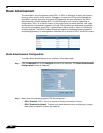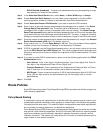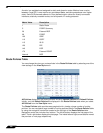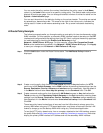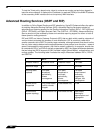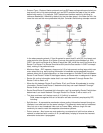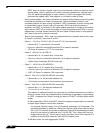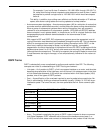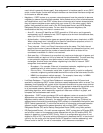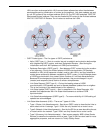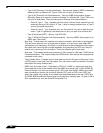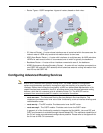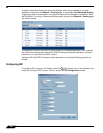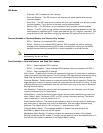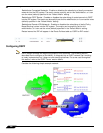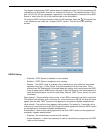
Network > Routing
234
SonicOS Enhanced 4.0 Administrator Guide
used, which is generally discouraged). Area assignment is interface specific on an OSPF
router; in other words, a router with multiple interfaces can have those interfaces configured
for the same or different areas.
• Neighbors – OSPF routers on a common network segment have the potential to become
neighbors by means of sending Hello packets. Hello packets act as a form of advertisement
and identification, and if two OSPF routers share a common set of certain characteristics,
they will become neighbors upon seeing their own router ID in the other router’s Hello
packet. Hello packets are also used in the DR (Designated Router) and BDR (Backup
Designated Router) election process. For two routers to become neighbors, the
characteristics that they must have in common are:
–
Area-ID – An area ID identifies an OSPF area with a 32 bit value, and is generally
represented in an IP address format. OSPF requires at a minimum the backbone area,
area 0 (or 0.0.0.0) for operation.
–
Authentication – Authentication types can generally be set to none, simple text, or MD5.
When using simple text, it should only be used for identification purposes, since it is
sent in the clear. For security, MD5 should be used.
–
Timer intervals – ‘Hello’ and ‘Dead’ intervals must be the same. The Hello interval
specifies the number of seconds between Hello packets (as a Keepalive function), and
the Dead interval specifies the number of seconds after which a router will be
considered unavailable if a Hello is not received.
–
Stub area flag – A Stub area is an area that only requires a single point of egress, and
therefore does not require a full list of external link advertisements. The stub area flag
on two potential neighbors must be the same to avoid inappropriate link state
exchanges. Another factor that affects neighboring is the kind of network. OSPF
recognizes three network types:
• Broadcast – For example, Ethernet. In broadcast networks, neighboring can be
established with all other routers in the broadcast domain.
• Point to Point – For example, serial links. In point to point (or point to multipoint)
networks, neighboring can be established with the router at the other end of the link.
• NBMA (non-broadcast multiple access) – For example, frame relay. In NBMA
networks, neighbors must be explicitly declared.
• Link State Database – The Link State Database is composed of the LSA’s sent and
received by neighboring OSPF routers that have created adjacencies within an area. The
database, once complete, will contain all the link state information for a given area, at which
time the Shortest Path First (SPF) algorithm will be applied to determine the optimal route
to all connected networks based on cost. The SPF algorithm employs the Dijkstra
pathfinding algorithm, which essentially regards all routers as vertices in a graph, and
computes the cost between each vertex.
• Adjacencies – OSPF routers exchange LSA’s with adjacent routers to create the LSDB.
Adjacencies are created in different fashions depending on the network type (see
Neighbors section above). Generally, the network type is broadcast (e.g. Ethernet) so
adjacencies are formed by the exchanging OSPF packets in a handshake-like fashion (see
OSPF Packet types below). To minimize the amount of information exchanged between
adjacent routers, segments (broadcast domains) with multiple OSPF routers elect a
Designated Router (DR) and a Backup Designated Router (BDR) using Hello packets.
• DR (Designated Router) – On multi-access segments, OSPF routers elect a DR and a BDR,
and all other routers on the segment create adjacencies with the DR and the BDR. DR
election is based on a router’s OSPF Priority, which is a configurable value from 0 (not
eligible for DR) to 255. The router with the highest priority becomes the DR. In the event of
a priority tie, the router with the highest Router ID (based on interface addressing) wins.
Once a router is the DR, its role is uncontested, until it becomes unavailable.



